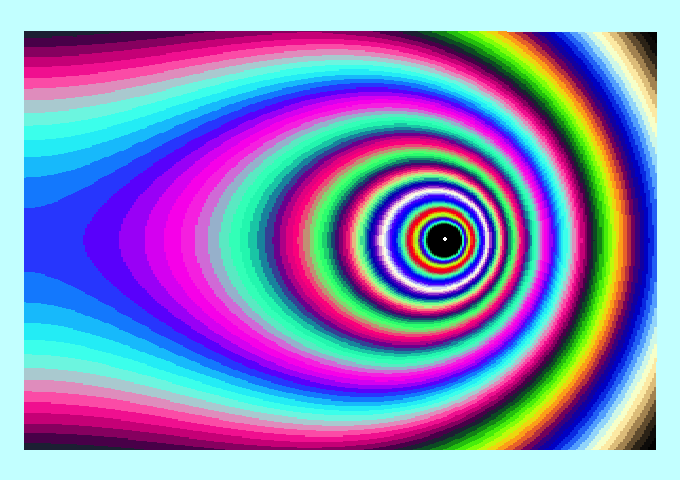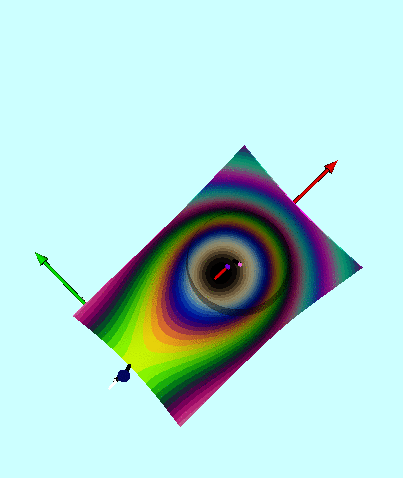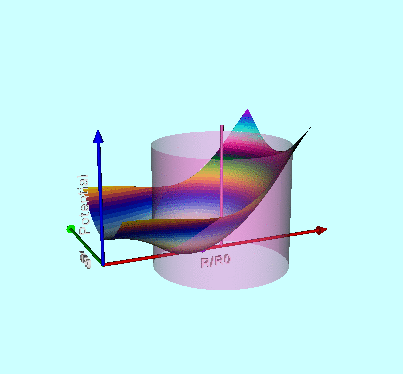User:Tohline/Apps/DWT
Common Theme: Determining the Gravitational Potential for Axisymmetric Mass Distributions
You have arrived at this page from our Tiled Menu by clicking on the chapter title that is also identified, below, by the light-blue-colored icon. You may proceed directly to that chapter by clicking (again) on that highlighted chapter icon. However, we have brought you to this intermediate page in order to bring to your attention that there are a number of additional chapters that have a strong thematic connection to the chapter you have selected. The common thread is the "Key Equation" titled, Gravitational Potential of an Axisymmetric Mass Distribution, that appears at the top of the following set of chapter synopses.

|
|---|
| | Tiled Menu | Tables of Content | Banner Video | Tohline Home Page | |
Chapter Synopses
Part I
The gravitational potential (both inside and outside) of any axisymmetric mass distribution may be determined from the following integral expression that we will refer to as the,
Gravitational Potential of an Axisymmetric Mass Distribution (Version 1)
|
<math>~\Phi(\varpi,z)\biggr|_\mathrm{axisym}</math> |
<math>~=</math> |
<math>~ - \frac{G}{\pi} \iint\limits_\mathrm{config} \biggl[ \frac{\mu}{(\varpi~ \varpi^')^{1 / 2}} \biggr] K(\mu) \rho(\varpi^', z^') 2\pi \varpi^'~ d\varpi^' dz^' </math> |
|
|
<math>\mathrm{where:}~~~\mu \equiv \{4\varpi \varpi^' /[ (\varpi+\varpi^')^2 + (z-z^')^2]\}^{1 / 2}</math> |
|||
and, <math>~K(\mu)</math> is the complete elliptic integral of the first kind. This Key Equation† may be straightforwardly obtained, for example, by combining Eqs. (31), (32b), and (24) from Cohl & Tohline (1999); see also, Bannikova et al. (2011), Trova, Huré & Hersant (2012), and Fukushima (2016).
†Building upon a previously little-known Compact Cylindrical Green's Function expansion, Cohl & Tohline (1999) derived an integral expression for the gravitational potential that is applicable to all mass distributions, irrespective of geometric symmetries. The Key Equation highlighted here — that is relevant to axisymmetric mass distributions — is a special case of this more general expression.
| Related Chapters (Part I) | |||||
|---|---|---|---|---|---|
In §102 of a book titled, The Theory of the Potential, MacMillan (1958; originally, 1930) derives an analytic expression for the gravitational potential of a uniform, infinitesimally thin, circular "hoop" of radius, <math>~a</math>. Throughout our related discussions, we generally will refer to this additional Key Equation from MacMillan as providing an expression for the, See also, §III.4, Exercise (4) in Kellogg (1929). As is reviewed in an accompanying chapter titled, Dyson-Wong Tori, a number of research groups over the years have re-derived this "thin ring" approximation in the context of their search for effective and insightful ways to determine the gravitational potential of axisymmetric systems. |
|||||
Deupree (1974) and, separately, Stahler (1983a) have argued that a reasonably good approximation to the gravitational potential due to any extended axisymmetric mass distribution can be obtained by adding up the contributions due to many thin rings — with <math>~\delta M(\varpi^', z^')</math> being the appropriate differential mass contributed by each ring element — that are positioned at various meridional coordinate locations throughout the mass distribution. According to Stahler's derivation, for example (see his equation 11 and the explanatory text that follows it), the differential contribution to the potential, <math>~\delta\Phi_g(\varpi, z)</math>, due to each differential mass element is:
Stahler's expression for each thin ring contribution is a generalization of the above-highlighted Key Equation expression for <math>~\Phi_\mathrm{TR}</math>: The "TR" expression assumes that the ring cuts through the meridional plane at <math>~(\varpi^', z^') = (a, 0)</math>, while Stahler's expression works for individual rings that cut through the meridional plane at any coordinate location. Given that, in cylindrical coordinates, the differential mass element is, <math>~\delta M = \rho(\varpi^', z^') \varpi^' d\varpi^' dz^' \int_0^{2\pi}d\varphi = 2\pi \rho(\varpi^', z^') \varpi^' d\varpi^' dz^'</math>, it is easy to see that Stahler's expression for <math>~\delta \Phi_g</math> is identical to the integrand of the expression that we have identified, above, as providing (Version 1 of) the Gravitational Potential of an Axisymmetric Mass Distribution. It is therefore clear that Deupree (1974) and, separately, Stahler (1983a) were developing robust algorithms to numerically evaluate the gravitational potential of systems with axisymmetric mass distributions well before Cohl & Tohline (1999) formally derived the corresponding Key integral expression. Note: It appears as though both Deupree (1974) and Stahler (1983a) only adopted this approach to evaluating the gravitational potential at locations outside of an axisymmetric mass distribution, whereas Cohl & Tohline (1999) have shown that the approach applies as well for locations inside the mass distribution. |
|||||
Part II
Suppose we rewrite (Version 1 of) the above-highlighted Key integral expression such that the (primed) coordinate location of each mass element is mapped from cylindrical coordinates <math>~(\varpi^', z^')</math> to a toroidal-coordinate system <math>~(\eta^',\theta^')</math> whose anchor ring cuts through the meridional plane at the cylindrical-coordinate location, <math>~(\varpi_a,z_a)</math>. This desired mapping is handled via the pair of relations,
|
<math>~\varpi^' = \frac{\varpi_a \sinh\eta^'}{(\cosh\eta^' - \cos\theta^')} \, ,</math> |
and |
<math>~(z^' - z_a) = \frac{\varpi_a \sin\theta^'}{(\cosh\eta^' - \cos\theta^')} \, ,</math> |
and the corresponding expression for each differential mass element is,
<math>~\delta M(\eta^',\theta^') = \biggl[\frac{2\pi \varpi_a^3 \sinh\eta^'}{(\cosh\eta^' - \cos\theta^')^3} \biggr] \rho(\eta^', \theta^') d\eta^' d\theta^'</math>.
This gives, what we will refer to as the,
|
Gravitational Potential of an Axisymmetric Mass Distribution (Version 2) |
||
|
<math>~\Phi(\varpi,z)\biggr|_\mathrm{axisym}</math> |
<math>~=</math> |
<math>~ - \frac{G}{\pi} \iint\limits_\mathrm{config} \biggl[ \frac{\mu}{\varpi^{1 / 2}} \biggr] \biggl[ \frac{\varpi_a \sinh\eta^'}{(\cosh\eta^' - \cos\theta^')} \biggr]^{- 1 / 2}K(\mu) \biggl[\frac{2\pi \varpi_a^3 \sinh\eta^'}{(\cosh\eta^' - \cos\theta^')^3} \biggr] \rho(\eta^', \theta^') d\eta^' d\theta^' </math>
|
|
|
<math>~=</math> |
<math>~ - 2G \biggl( \frac{\varpi_a^5}{\varpi} \biggr)^{1 / 2} \iint\limits_\mathrm{config} \biggl[\frac{ \sinh\eta^'}{(\cosh\eta^' - \cos\theta^')^5} \biggr]^{1 / 2} \mu K(\mu) \rho(\eta^', \theta^') d\eta^' d\theta^' \, ,</math>
|
where the square of the argument of the elliptic integral is,
|
<math>~\mu^2</math> |
<math>~=</math> |
<math>~ \frac{ 4\varpi \varpi_a \sinh\eta^'}{(\cosh\eta^' - \cos\theta^')}\biggl\{ \biggl[ \varpi+ \frac{\varpi_a \sinh\eta^'}{(\cosh\eta^' - \cos\theta^')} \biggr]^2 + \biggl[z- z_a - \frac{\varpi_a \sin\theta^'}{(\cosh\eta^' - \cos\theta^')} \biggr]^2 \biggr\}^{-1} \, . </math> |
| Related Chapter (Part II) | |||||||||
|---|---|---|---|---|---|---|---|---|---|
Referencing (equivalently, Version 1 of) the above-identified integral expression for the Gravitational Potential of an Axisymmetric Mass Distribution, Trova, Huré & Hersant (2012) offer the following assessment in §6 of their paper:
We also have wondered whether there is a possibility of converting the double integral in this Key Equation into a single (line) integral. This is a particularly challenging task when, as is the case with Version 1 of the expression, the integrand is couched in terms of cylindrical coordinates because the modulus of the elliptic integral is explicitly a function of both <math>~\varpi^'</math> and <math>~z^'</math>. We have realized that if we focus, instead, on Version 2 of the expression and associate the meridional-plane coordinates of the anchor ring with the coordinates of the location where the potential is being evaluated — that is, if we set <math>~(\varpi_a, z_a) = (\varpi,z)</math> — the argument of the elliptic integral becomes, <math>~\mu = \biggl[\frac{2}{1+\coth\eta^' }\biggr]^{1 / 2} \, ,</math> while the integral expression for the gravitational potential becomes,
Notice that, by adopting this strategy, the argument of the elliptical integral is a function only of one coordinate — the toroidal coordinate system's radial coordinate, <math>~\eta^'</math>. As result, the integral over the angular coordinate, <math>~\theta^'</math>, does not involve the elliptic integral function. Then — as is shown in an accompanying chapter titled, Attempt at Simplification — if the configuration's density is constant, the integral over the angular coordinate variable can be completed analytically. Hence, the task of evaluating the gravitational potential (both inside and outside) of a uniform-density, axisymmetric configuration having any surface shape has been reduced to a problem of carrying out a single, line integration. This provides an answer to the question posed by Trova, Huré & Hersant (2012). |
|||||||||
Part III
Now, beginning with Version 2 of our expression for the Gravitational Potential of Axisymmetric Mass Distributions, let's also map the (unprimed) cylindrical coordinate pair, <math>~(\varpi, z)</math>, to the same (but, unprimed) toroidal coordinate system, <math>~(\eta,\theta)</math>, and place the toroidal coordinate system's anchor ring in the equatorial plane of the cylindrical-coordinate system such that, <math>~(\varpi_a,z_a) = (a,0)</math>. This gives, what we will refer to as the,
|
Gravitational Potential of an Axisymmetric Mass Distribution (Version 3) |
||
|
<math>~\Phi(\varpi,z)\biggr|_\mathrm{axisym}</math> |
<math>~=</math> |
<math>~ - 2G a^2 \biggl[ \frac{(\cosh\eta - \cos\theta)}{\sinh\eta} \biggr]^{1 / 2} \iint\limits_\mathrm{config} \biggl[\frac{ \sinh\eta^'}{(\cosh\eta^' - \cos\theta^')^5} \biggr]^{1 / 2} \mu K(\mu) \rho(\eta^', \theta^') d\eta^' d\theta^' \, ,</math>
|
|
<math>\mathrm{where:}~~~\mu^2 = \frac{ 2 \sinh\eta^'\cdot \sinh\eta}{ \sinh\eta^'\cdot \sinh\eta + \cosh\eta^'\cdot\cosh\eta -\cos(\theta^' - \theta) } \, .</math> |
||
| Related Chapters (Part III) | |||||||||||||||||||||||||||||||||||||||
|---|---|---|---|---|---|---|---|---|---|---|---|---|---|---|---|---|---|---|---|---|---|---|---|---|---|---|---|---|---|---|---|---|---|---|---|---|---|---|---|
Referencing [MF53], Wong (1973) developed an integral expression for the Coulomb (equivalently, gravitational) potential whose foundation is the single summation, Green's function expression for the reciprocal distance between two points in toroidal coordinates. For axisymmetric mass distributions‡, Wong obtained,
where, <math>~P^m_{n-1 / 2}, Q^m_{n-1 / 2}</math> are Associated Legendre Functions of the first and second kind of order, <math>~m</math>, and half-integer degree, <math>~n - 1/2</math> (toroidal functions). Recognizing that the <math>~m=n=0</math> toroidal function of the second kind can be expressed in terms of the complete elliptic integral of the first kind via the relation,
<math>~Q_{-1 / 2}(\Chi) = \mu K(\mu)\, ,</math> where, <math>~\Chi \equiv \biggl[ \frac{2}{\mu^2} - 1\biggr] \, ,</math>
Abramowitz & Stegun (1995), p. 337, eq. (8.13.3) we see that Version 3 of our integral expression for the Gravitational Potential of an Axisymmetric Mass Distribution may be rewritten as,
Even though these two expressions for the axisymmetric potential are written entirely in terms of identically defined toroidal coordinate systems, they appear to be very different from one another. In the accompanying chapter titled, Using Toroidal Coordinates to Determine the Gravitational Potential, we detail step-by-step how the first of these expressions can be transformed into the second, thereby proving that they are indeed perfectly equivalent integral expressions for the gravitational potential of axisymmetric systems. ------------------------------
‡Wong (1973) actually derived a toroidal-coordinate-based integral expression for the Coulomb (equivalently, gravitational) potential that is applicable to all charge (mass) distributions, irrespective of geometric symmetries. The expression highlighted here — that is relevant to axisymmetric mass distributions — is a special case of this more general expression. |
|||||||||||||||||||||||||||||||||||||||
Beginning with his integral expression for <math>~\Phi(\eta,\theta)|_\mathrm{axisym}</math>, Wong (1973) was able to complete the integrals in both coordinate directions and obtain an analytic expression for the potential both inside and outside of a uniformly charged (equivalently, uniform-density), circular torus. This is a remarkable result that has been largely unnoticed and unappreciated by the astrophysics community. We detail how he accomplished this task in an accompanying chapter titled, Wong's (1973) Analytic Potential. If a torus has a major radius, <math>~R</math>, and cross-sectional radius, <math>~d</math>, Wong realized that every point on the surface of the torus will have the same toroidal-coordinate radius, <math>~\eta_0 = \cosh^{-1}(R/d)</math>, if the anchor ring of the selected toroidal coordinate system has a radius, <math>~a = \sqrt{R^2 - d^2}</math>. His derived expressions for the potential — one, outside, and the other, inside the torus — are:
Does this expression for the potential behave as we expect in the "thin ring" approximation? On p. 295 of Wong (1973), we find the following statement:
Using the notation, <math>~\Phi_\mathrm{W0}</math>, to represent the leading-order term in the expression for the exterior potential, we have (see the accompanying chapter for details),
where,
In our accompanying discussion we show that,
Hence, we have,
which precisely matches the above-referenced Gravitational Potential in the Thin Ring (TR) Approximation. |
|||||||||||||||||||||||||||||||||||||||
Related Discussions

|
|---|
|
© 2014 - 2021 by Joel E. Tohline |


